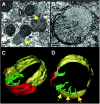Consequences of Folding the Mitochondrial Inner Membrane
- PMID: 32581834
- PMCID: PMC7295984
- DOI: 10.3389/fphys.2020.00536
Consequences of Folding the Mitochondrial Inner Membrane
Abstract
A fundamental first step in the evolution of eukaryotes was infolding of the chemiosmotic membrane of the endosymbiont. This allowed the proto-eukaryote to amplify ATP generation while constraining the volume dedicated to energy production. In mitochondria, folding of the inner membrane has evolved into a highly regulated process that creates specialized compartments (cristae) tuned to optimize function. Internalizing the inner membrane also presents complications in terms of generating the folds and maintaining mitochondrial integrity in response to stresses. This review describes mechanisms that have evolved to regulate inner membrane topology and either preserve or (when appropriate) rupture the outer membrane.
Keywords: chemiosmosis; crista junctions; cristae; membrane remodeling; membrane topology; mitochondria.
Copyright © 2020 Mannella.
Figures

Similar articles
-
Effect of crista morphology on mitochondrial ATP output: A computational study.Curr Res Physiol. 2021;4:163-176. doi: 10.1016/j.crphys.2021.03.005. Epub 2021 Apr 1. Curr Res Physiol. 2021. PMID: 34396153 Free PMC article.
-
Electron tomography of mitochondria from brown adipocytes reveals crista junctions.J Bioenerg Biomembr. 1998 Oct;30(5):431-42. doi: 10.1023/a:1020586012561. J Bioenerg Biomembr. 1998. PMID: 9932646
-
ChChd3, an inner mitochondrial membrane protein, is essential for maintaining crista integrity and mitochondrial function.J Biol Chem. 2011 Jan 28;286(4):2918-32. doi: 10.1074/jbc.M110.171975. Epub 2010 Nov 16. J Biol Chem. 2011. PMID: 21081504 Free PMC article.
-
Topology of the mitochondrial inner membrane: dynamics and bioenergetic implications.IUBMB Life. 2001 Sep-Nov;52(3-5):93-100. doi: 10.1080/15216540152845885. IUBMB Life. 2001. PMID: 11798041 Review.
-
Role of the mitochondrial contact site and cristae organizing system in membrane architecture and dynamics.Biochim Biophys Acta Mol Cell Res. 2017 Apr;1864(4):737-746. doi: 10.1016/j.bbamcr.2016.05.020. Epub 2016 Sep 7. Biochim Biophys Acta Mol Cell Res. 2017. PMID: 27614134 Review.
Cited by
-
Mitochondrial Contact Site and Cristae Organization System and F1FO-ATP Synthase Crosstalk Is a Fundamental Property of Mitochondrial Cristae.mSphere. 2021 Jun 30;6(3):e0032721. doi: 10.1128/mSphere.00327-21. Epub 2021 Jun 16. mSphere. 2021. PMID: 34133204 Free PMC article.
-
Deregulated mitochondrial microRNAs in Alzheimer's disease: Focus on synapse and mitochondria.Ageing Res Rev. 2022 Jan;73:101529. doi: 10.1016/j.arr.2021.101529. Epub 2021 Nov 20. Ageing Res Rev. 2022. PMID: 34813976 Free PMC article. Review.
-
Hubbing the Cancer Cell.Cancers (Basel). 2022 Nov 30;14(23):5924. doi: 10.3390/cancers14235924. Cancers (Basel). 2022. PMID: 36497405 Free PMC article. Review.
-
Muscarinic Receptor Antagonism and TRPM3 Activation as Stimulators of Mitochondrial Function and Axonal Repair in Diabetic Sensorimotor Polyneuropathy.Int J Mol Sci. 2025 Jul 31;26(15):7393. doi: 10.3390/ijms26157393. Int J Mol Sci. 2025. PMID: 40806522 Free PMC article. Review.
-
Mitochondrial Membranes and Mitochondrial Genome: Interactions and Clinical Syndromes.Membranes (Basel). 2022 Jun 15;12(6):625. doi: 10.3390/membranes12060625. Membranes (Basel). 2022. PMID: 35736332 Free PMC article. Review.
References
Publication types
Grants and funding
LinkOut - more resources
Full Text Sources

